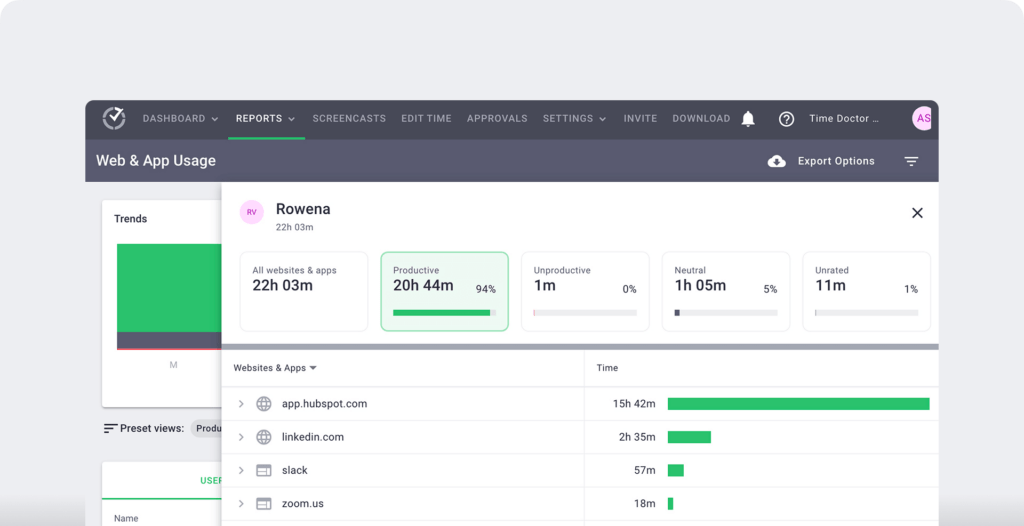Between employees, equipment, and technology, call centers can quickly become cost centers. If you align with the 54% of CFOs who intend to focus on cost reduction, you can’t afford to run an overly expensive contact center.
So, how can you keep costs in check and avoid letting your expenses bloat? Let’s cover 11 tactics for tackling call center cost savings, including ideas for everything from advanced technology to employee retention.
1. Leverage productivity analytics
Labor costs are easily one of the most significant line items for a contact center. That’s why one of the most intelligent ways to unlock cost center savings is to maximize your team’s output without incurring additional expenses.
To track and optimize output, you need productivity analytics. By evaluating employee productivity, you can uncover several insights:
- See how your team performs and guide them toward more efficient workflows.
- Benchmark performance and measure the impact of new initiatives and programs.
- Identify unnecessary expenses and reallocate resources across the organization.
- Find areas for growth so you can continue to optimize performance and increase revenue.

The key to implementing productivity analytics is automatically collecting data for every task completed and hour worked. With workforce management software, you can identify what’s costing you the most and take action to reduce or reallocate costs.
Time Doctor automatically collects attendance, activity, and productivity data as your call center agents work. Our time tracking platform works in the background, recording when employees log in and out for the day and how they spend their working hours. Here’s how Time Doctor can optimize your team’s productivity:
- Track the projects and tasks employees work on, automatically creating a visual timeline of their day.
- Monitor apps and websites to see which tools are used most and which you can potentially cut.
- Compare active versus idle time to see which employees have room for improvement.
- Measure productive time, which reveals the employees making the best use of their workday.

Since Time Doctor integrates with popular help desk and call center software, it can easily plug into your tech stack. As a result, you can easily link productivity analytics with Zendesk, Intercom, Genesys, and other call center platforms.
2. Switch to cloud-based hosting
Hosting on-site call center infrastructure can be a cost-effective decision. When you go this route, you manage everything on premises, from communication servers to software and hardware. Since your on-site team is responsible for installing, maintaining, and updating this infrastructure, you have almost complete control over the costs.
However, on-premises hosting may be more expensive than it seems. Since you’re responsible for installation and maintenance, you need a dedicated IT team to manage the infrastructure. You may also have a lot of capital expenses each time you upgrade equipment.
With cloud-based solutions, you leave the installation, maintenance, and upgrades to your provider. In most cases, you’re only responsible for a monthly subscription fee, which usually depends on the size of your user base. Since virtually all hosting providers offer a service level agreement (SLA), you can expect close to 100% uptime.
To calculate the cost savings, compare your current on-premises costs to the average cost of a cloud-based software subscription. Platforms like Aircall start at $40/user per month, while tools like Zendesk start at $69/user per month.
3. Open a virtual call center
Whether you plan to switch to cloud-based call center software or have already implemented one of these platforms, the next step is running a virtual contact center. When your software is cloud-based, there’s little need to require your team to work on site.
Switching from an in-person business to an exclusively remote organization can lead to significant cost savings. Call centers that make this change reduce costs by an average of 27%, according to Talkdesk. At the same time, many other metrics have the potential to increase. For example, virtual call centers have 35% less downtime on average.
To calculate your cost savings, consider all your current operations expenses. Space rentals or commercial leases aren’t necessary for virtual call centers, but you must still account for capital expenses like laptops and headsets.
4. Reduce inbound call volume
Do you find that increased call volumes have forced you to ramp up your team, creating additional expenses for your cost center? The most effective way to address these cost concerns is by reducing inbound call volume while still serving clients.
How? Build out self-service options for support. The more robust your online knowledge bases and help portals are, the more customers can find the answers they need independently. As a result, you have fewer calls to manage and less of a need to incur more staffing costs.
Do you already have a comprehensive knowledge base, but customers don’t seem to use it? Work with your team to increase its visibility and make it more user-friendly. For example, you can feature it on your site’s most popular pages or install a chatbot to answer questions.
Encouraging self-service support could save you much more than you might think. The average cost per contact for a live agent is around $8, while the average cost per contact for self-service is $0.10, according to Gartner.
5. Optimize call routing
Relying on manual call routing may be simpler and require less tech, but it can become extremely expensive for call centers. If you’re looking for cost-reduction strategies that improve customer experience, focus on optimizing your call routing.
With interactive voice response (IVR) technology, customers first engage with automated phone menus. Once they choose options that align with their goal or concern, the tech automatically routes them to the right group of agents.
As a result, IVR can help customers resolve issues more efficiently while taking less agent time. Since software like RingCentral and Five9 automatically routes customers based on their needs, it can also reduce callbacks.
Improving call routing and implementing IVR tech can be incredibly cost-effective for contact centers. Compared to the cost of relying exclusively on a live agent, using IVR can cost 48 times less, according to Twilio.
6. Decrease average handle time
While self-service support and optimized call routing can decrease the time spent on phone calls, they’re far from the only solutions. If you find your agents spend too much time resolving customer issues, take steps to decrease average handle time (AHT).
How can this approach help with cost savings? When agents spend less time on each call, they can take more calls overall. As a result, you need fewer agents to handle the same call volume while still providing the same level of customer service.
The potential cost savings from this approach depend on your staffing costs and how much you can decrease AHT. For example, if a typical call incurs $5 in staffing costs and you can reduce this metric by 10%, you can save $0.50 per call.
To reduce AHT, improve the scripts used to respond to customer concerns. Another option is adopting knowledge-based software like Knowmax or Document360 for agents.
7. Increase customer satisfaction scores
Decreasing AHT and implementing IVR can lead to higher customer satisfaction scores (CSAT). However, if your CSAT scores still aren’t where you want them to be or you still receive negative customer feedback, you still have work to do.
Why is CSAT so essential for cost reduction? The higher the cost per call is, the longer the call lasts, which often correlates with low customer satisfaction. Conversely, ensuring that calls are more effective and efficient generally leads to higher CSAT and lower costs.
The key is identifying the call center metric that most substantially affects CSAT. In addition to AHT, consider focusing on these metrics:
- First call resolution (FCR): tracking how often agents address issues during initial interactions with customers
- Call abandonment rate (CAR): reflecting how common it is for customers to hang up without a resolution
8. Improve call center forecasting
To keep CSAT as high as possible, you need adequate staff available to answer calls. However, hiring or scheduling too many agents for any period can become expensive quickly.
To maintain good customer service while keeping costs in check, you need an accurate estimate of the call volume your agents have to handle. In other words, you need better call center forecasting.
The first step is choosing a call center forecasting method. For example, triple exponential smoothing or neural networks may better fit your use case. The industries your call center serves and the amount of historical data you have both affect which option is best for your contact center.
Once you’re satisfied with the accuracy of your forecast, reassess your staffing and scheduling needs. Aim to have enough agents on staff to meet your call center’s needs while accounting for paid time off (PTO) and turnover.
How much can you save with better forecasting? It depends on how much you overestimated call volume or overscheduled agents—and how much your revised forecast allows you to dial back both metrics.
9. Adopt AI and automation
Without AI and automation tools, your contact center likely isn’t operating as efficiently as possible, causing you to spend unnecessarily. Many contact center software platforms already offer these tools, which may mean you can adopt them without incurring additional expenses.
Automation tools like predictive dialers can significantly increase productivity and agent output for outbound teams. These tools call provided phone numbers automatically and connect customers to available agents rather than relying on agents to initiate each call manually. For example, Convoso’s predictive dialer can increase contact rates by 300%.
AI tools can also help improve call outcomes, reducing AHT and improving CSAT. Contact center software like Dialpad that uses natural language processing (NLP) can analyze calls and suggest scripts, responses, or next steps in real time. As a result, agents can help customers reach the right resolution more efficiently.
10. Invest in agent development
Some call center agent attrition is inevitable. However, high turnover rates can be unnecessarily expensive for contact centers. Replacing a contact center agent costs $30,000 to $50,000 on average. As a result, increasing employee retention rates can lead to significant cost savings.
One way to retain agents is to enable them to acquire new skills and recognize them for good work. Call center agent training and development can take many forms. Depending on your team’s needs and preferred learning styles, you can consider gamification, microlearning initiatives, or personalized learning and development libraries.
11. Review your call center tech stack
As your team grows and your call center expands, you’ll likely need more software to manage additional channels or provide better service. However, it’s easy to lose track of all the subscriptions you’ve purchased and all the seats you have. If you have tools or seats you don’t need, you could be wasting thousands of dollars each month.
Right-sizing your software subscriptions is just one step in the process. It’s just as vital to confirm you’re using the right software. Ideally, every tool in your tech stack communicates with the others, so you don’t have to waste resources on duplicating work.
Review your call center tech stack and consider how each platform integrates with the others. At times, it may be more cost-effective to switch to platforms that work better together or consolidate tools. For example, 8×8 offers contact center software and built-in team chat tools, while CloudTalk has inbound and outbound tools.
Next steps to reduce costs with productivity analytics
From improving call center metrics to investing in agent development, you have several cost-reduction strategies to consider. That said, if you’re serious about decreasing expenses and increasing revenue, improving agent productivity is one of the most important steps you can take.Curious how much you could save and how to get started? Download our guide to cost saving through productivity analytics.

Andy is a technology & marketing leader who has delivered award-winning and world-first experiences.


